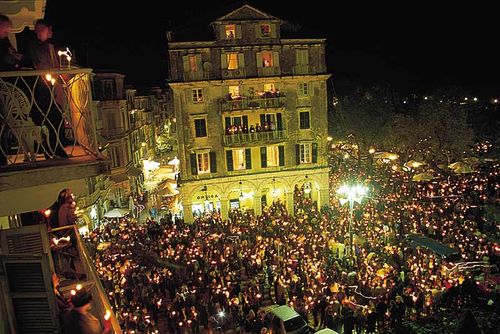 |
| Paschal fire, Greece |
Holy week is the 7 days before and including Easter Sunday. This is truly the best time of year to be in Greece no matter what you believe in. The locals will go to Church every day throughout this week as special liturgies are read each day. In the morning on Holy Thursday the parishioners are called to receive Holy Communion which represents the earthly presence of Christ as it did at the last supper. In the evening of Holy Thursday the Greek Orthodox Church will have the preparation for the “Epitafi,” which literally translates to funeral. That evening parishioners will prepare a symbolic coffin, lavishly adorned with flowers and have it available for viewing at the Church. It is the reliving of events leading up the crucifixion and burial of Christ.
Waking up for your first time on Good Friday is something you will never forget as long as you live. The church bells start ringing very early in the morning with a slow ominous “ding… ding, ding… ding.” This goes on throughout the day at specific intervals. In Greece when a person dies the Church rings the bell in the morning to notify the parishioners that there will be a burial that day. On Good Friday the bells ring throughout the day as a constant reminder and the quiet of the day will bring upon a sort of gloom in the air that is undeniable. In the afternoon the priest will take the body of Christ down from the crucifix, wrap it in a shroud and place it on the altar. Following the service called “the Lamentations at the Tomb,” the priest will carry the Epitaphios (which is a painted cloth likeness of Christ) and place it in the coffin as a symbol of the Tomb of Christ. The priest will then lead a procession out of the Church and into the village square. Each parishioner will hold a lit candle and chant as they walk around the square.
I can describe Good Friday in as much detail as possible but there is one aspect present that you can only understand if you are physically there to experience it. As you are walking with your lit candle in the procession or if you are just looking upon it from the sidelines, you will become overwhelmed with a feeling of unity. Looking over thousands of candles in the hands of men, women and children, people in the square, those on their balcony overlooking the square, shop owners standing on their doorsteps with a candle in hand, the chanting, the mourning… This is an entire community coming together in lamentation over the death of Jesus Christ. It is not the typical Sunday and dragging yourself out of bed to be a good Christian who goes to Church. This is people out in the street, rain or wind and holding a candle and being part of something. So many will have tears in their eyes, it is the mourning of the death of Christ and it is overwhelming. Then, when thinking about it even more you realize that it is not only this small community but the entire country has stopped everything completely to take to the streets and join a procession of mourners. Then you realize… it is not only in Greece but this is happening all over the world. You become part of something so very important, so vast that it has transcended more than 2000 years and has landed right in your hands as you hold a candle and begin to weep in awe of it all. It gives rise to so many other realizations and questions and once you have experienced this, life has changed somehow.
By now you and your family will have purchased your “lambadas.” These are the candles you will use on Holy Saturday to receive the Holy Fire. Lambadas are a huge business in Greece as everyone must have one and they are decorated lavishly. For the children they come with game packs, toys and in just about every theme you can imagine. You might also want to get a small lantern to bring the flame home with you, burning the doorframe slightly as you enter to keep evil out.
Holy Saturday is marked with the Greek Patriarch receiving the Holy Fire from Jerusalem. This is another amazing event and a true miracle that takes place every year. There is a church called the “Church of the Resurrection” located in the Old City of Jerusalem (also called the “Church of the Holy Sepulchre”). The Tomb of Christ is located here and at noon on Holy Saturday, several important Patriarchs enter the area known as the “Sepulchre” and pray. After their prayers a miraculous light emerges and two candles are lit from it. The area is packed with people and as soon as the first two candles are lit, other candles light spontaneously. At first the fire does not burn to the touch and many people will put their hands and faces into the flames without being burned. The flame is handed from person to person by candle and flown all over the world. Throughout the day the candle is passed from priest to priest, church to church and finally just before midnight the parishioners will go out into the courtyard of the Church and receive the flame for their lambadas. Moments later at precisely midnight, the church bells will ring frantically signifying the resurrection of Christ. The priest will loudly proclaim “Christos Anesti,” (Christ has risen)!! Fireworks and fire crackers can be heard everywhere; there is no sleep for the wicked this night!
 |
| Paschal soup μαγειρίτσα (Magiritsa) |
By Lori Messina
